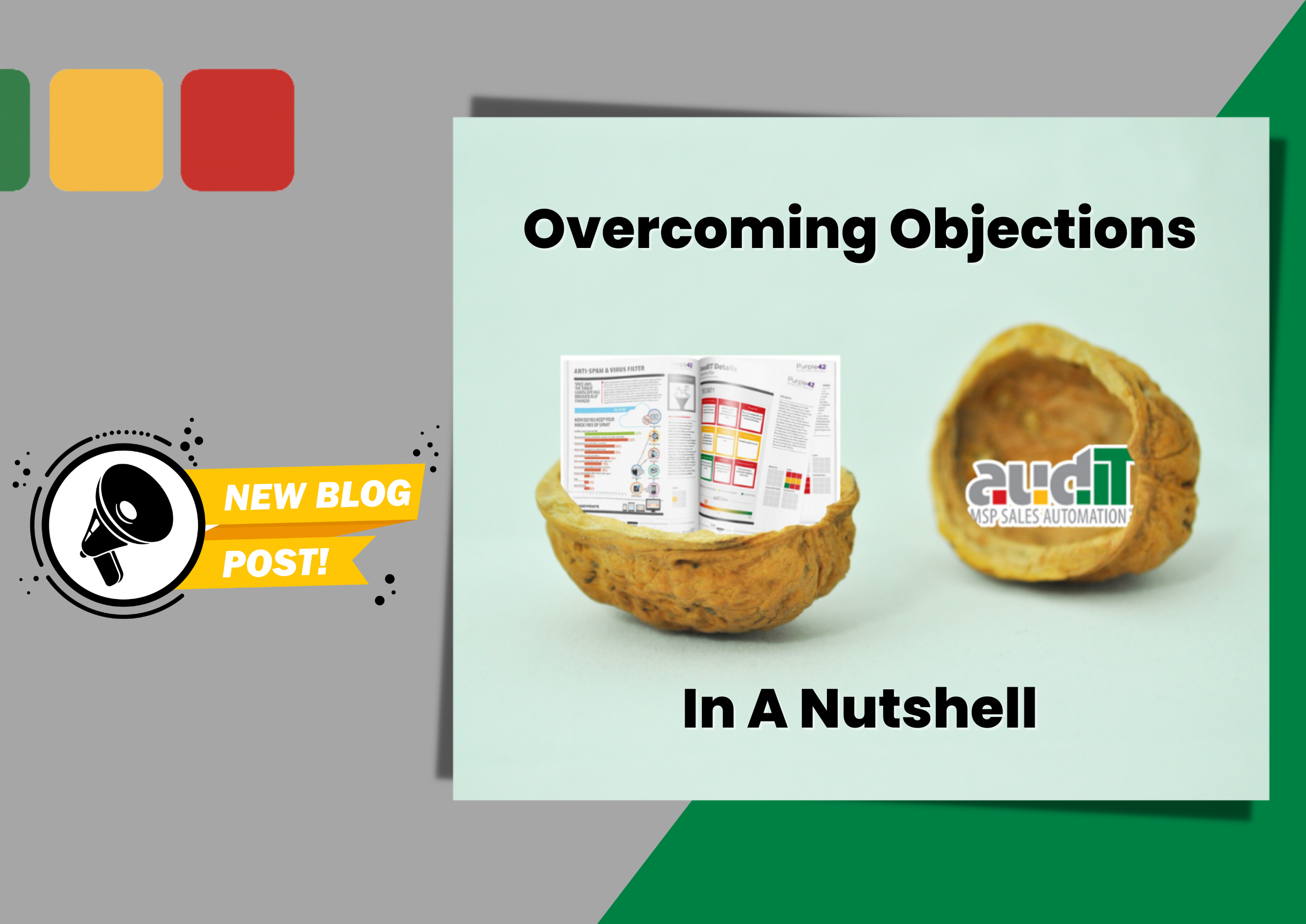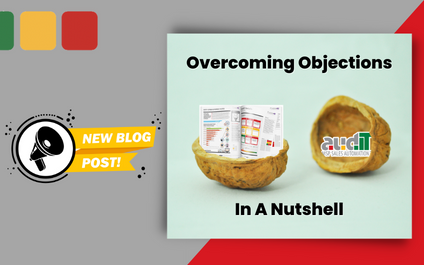
Before I share how you can overcome objections, let’s have a reality check. There are a few truths when it comes to sales and objections:
1: The only way to never hear an objection is to stop selling. As much as I’d love to tell you that you can do this to never hear an objection again, that just isn’t reality.
2: Sometimes, especially if it comes up early, an objection is very helpful.
Imagine I prospected one of your clients. I asked them if they’d like me to come in and do an audIT on their IT to make sure their current MSP, (you), is doing a good job.
They tell me they just had a 3rd party do that. And the current MSP, (you), passed with flying colors.
This prospect is so happy with you, they tell me they just signed a new three-year contract with you and have a big new project coming up.
I can try to argue with them. I can think of it as overcoming this objection.
Or I can thank them for their time, realize they’re not a qualified prospect for me, and move on. Now I am freed up to continue looking for a prospect who isn’t happy with their current MSP.
3: There is no magic button, trick, secret, or hack to overcome objections. But what I’ll cover here will be the closest thing MSPs can get to one. It still takes planning and effort.
4: Many times, the objection isn’t the real reason. Sometimes people just don’t know or they’re playing their cards close to their chest. Keep reading to see how you can uncover the real reasons.
5: How you handle objections from one product, company, or industry may vary greatly. What works for some, may not work for others. There are no one-sized fits all objection training. This article is specifically designed for and works for MSPs selling high-value IT solutions.
6: You cannot argue a prospect into believing they are wrong. Even if they are wrong.
7: Nor can you argue someone into buying.
8: Most objections can and should be overcome before they even come up. And this is the crux of what this article is about.
How to prevent objections before they become an objection
It is said that if you don’t ask great questions, the sale is lost right from the start. This is only partially true for MSPs.
For MSPs, you must ask great questions. This is a non-starter. But there’s more to it…
First, what exactly is a great question?
There are two types of questions you need to ask as an IT provider.
1: Technical questions
2: Business questions
Of course, you have no choice but to ask technical questions. However, many of these you can and should answer yourself by walking through their environment.
The more technical you get with your prospects and customers, the more glazed over their eyes get. The more confused they will become. And a confused mind never buys.
You also don’t need to have the forensic level schematics of their server to understand if it fits their business needs. I promise you this is true.
You only need as much technical information on their environment necessary to uncover enough to make the sale.
Try to answer as many technical questions as possible on your own. Even when asking technical questions, try to word them as non-technical as you can.
The real value comes when you ask business questions
Starting with asking about the problems that prompted them to bring you in to do the technical assessment in the first place.
Once you get those answers, be mindful that these may not be the problems. Many times, people call you for one thing and the problem is something else. It’s your job to probe deeper in a consultative way to get the real problem.
For example, I once went to a doctor because I was having pain in my foot. He asked me a bunch of questions and in the end, sent me for a test on my neck.
Turned out the real problem was a pinched nerve in my neck. Who knew?
Beware: problems alone don’t sell anything
People don’t buy solutions to problems. They buy the impact a solution will have on their business. They buy value. They buy outcomes.
To get to these deeper business needs, you need to ask questions that dig further than the surface-level problem. These questions need to reveal the impact this problem is having on their business.
But that still isn’t enough. You must then dig even deeper to reveal the real cause of these problems.
Remember, the real cause may not be what they thought it was at the start. Keep asking until you uncover the real root cause.
But that still isn’t enough. You need to connect this to the outcome they want. This is also called their ‘future state’.
Do they want this problem resolved? On a scale from 0 to 10, if the problem causes them a pain level of 1, maybe it’s not worth all the effort of changing IT providers to solve such a small problem.
This is exactly where objections crop up. The MSP hears a problem and then presents to that problem. But to the prospect, it isn’t a level 10 problem so naturally, they bring up some kind of objection like price.
Understanding their needs and the outcomes they want will help you move the 1 to 10. And that widens the gap between where they are today (current state), and where they can be when they become your customer (future state).
A 1 on the pain scale is sure to get you an objection when you present your solution. Uncover those 10’s.
People also don’t buy the best solution. They buy what they ‘think’ is the best solution. And that is almost always from whoever communicates the clearest.
Now that you’ve uncovered the problems, business impact, and outcomes desired; you need to communicate it in a way that triggers the right response.
As an MSP, you must be able to communicate these findings in a way that a non-technical business buyer will understand. They must connect the dots between the answers to those questions and how it will ultimately help them protect and grow their business.
To sum it all up, as an MSP, your job is to:
1: Learn their current state, the problems they’re having in their current state, the impact this is having on their business, and the outcome they need and want in a future state.
2: Then you need to present your findings in a clear, simple, and emotionally impactful way so they can see the gap between the current state and future state.
If you do this properly you should not have to overcome any objections. They won’t have any.
Most times an objection comes up, we have not done something right in these two areas. Objections mean they don’t understand something within these two parts of the process.
This is exactly what audIT was built to do for MSPs like you
audIT comes with a Fact Finder template that lets you build a framework to follow in your technical assessment.
You can pre-load your Fact Finder with the technical questions you need to uncover. These go along exactly with what your presentation will look like. Making putting a compelling and persuasive presentation together easy for you and your team.
Then you have business questions that let you uncover the real problems, impact, causes, and outcomes.
Then you simply use the audIT presentation templates to generate a visually compelling presentation that sells for you.
The audIT templates will demonstrate in a simple and non-technical way the prospect’s current state, future state, and the value gap between them. audIT will help you overcome any objection before it comes up.
audIT practically does the selling for you. Book a demo to see for yourself!

